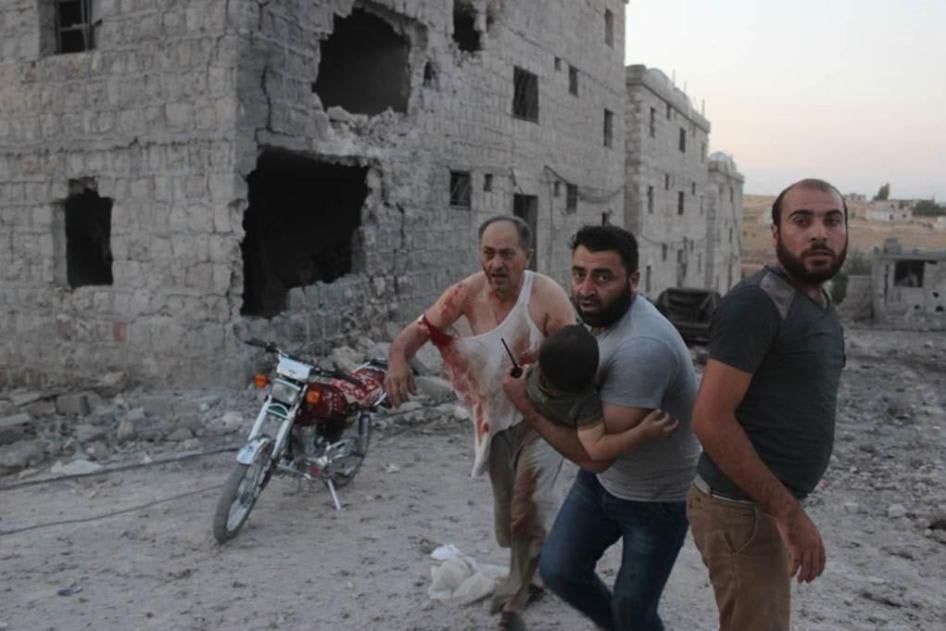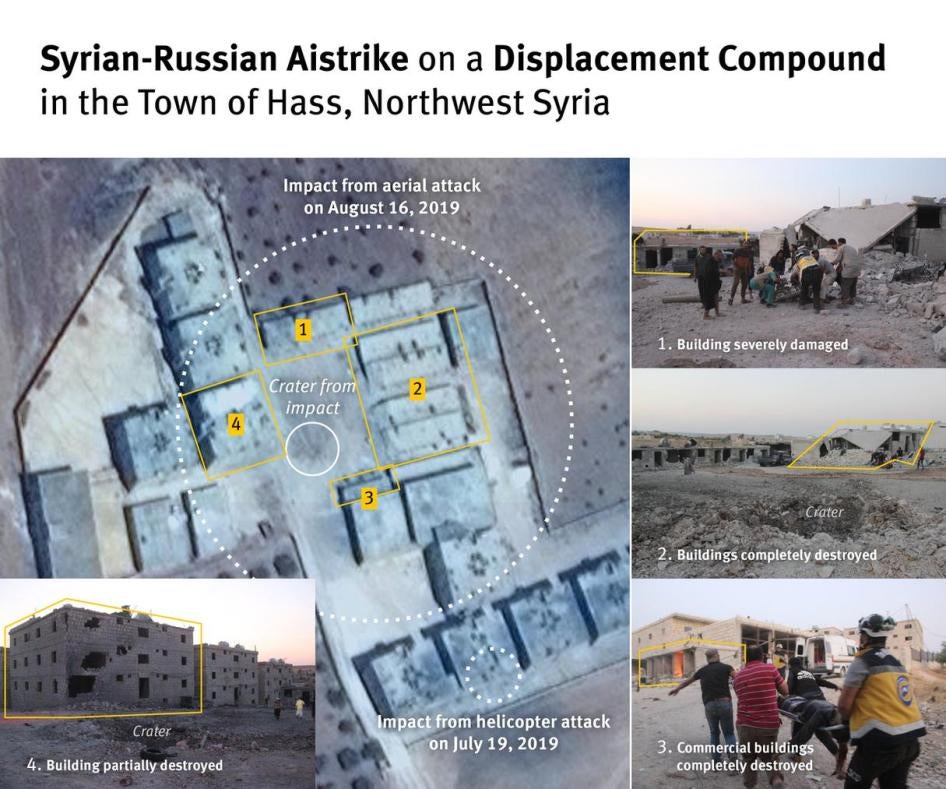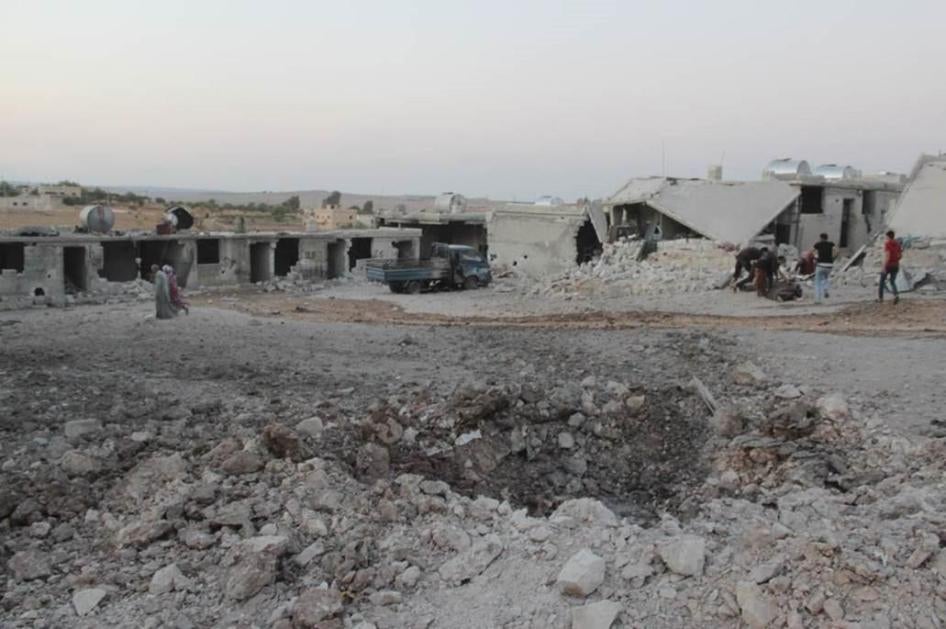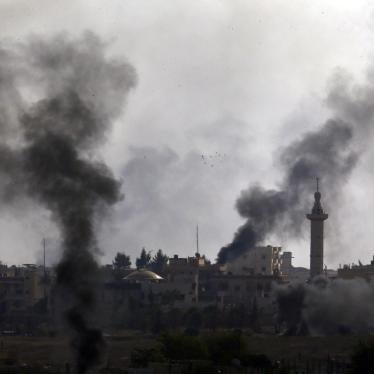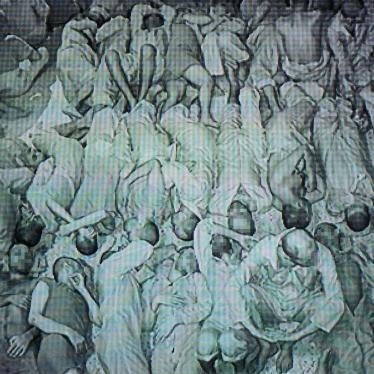(Beirut) – A Syrian-Russian military alliance strike on a displacement compound in mid-August is an apparent war crime, Human Rights Watch said today.
Witnesses said there was no apparent military target for the attack in the town of Hass, in Idlib governorate. The strike killed at least 20 civilians at the center and displaced about 200 survivors. They fled to nearby villages and displacement compounds along the closed Turkish border under the control of the anti-government groups, where hundreds of thousands of other displaced Syrians are trapped with nowhere left to flee.
“Since the start of the offensive on Idlib, the Syrian-Russian military alliance has used unlawful tactics to kill and injure hundreds of civilians,” said Gerry Simpson, associate crisis and conflict director at Human Rights Watch. “The tragic loss of life and injury to civilians is made worse by the devastating impact these attacks have had on civilian infrastructure, bringing an ongoing displacement crisis in Syria to its breaking point.”
In April, the Syrian-Russian alliance escalated its military campaign on Idlib governorate and other parts of Northwest Syria, the last anti-government stronghold in the country. In its offensive, the alliance has killed at least 1,000 civilians and displaced over half a million others, according to the United Nations. The alliance has also struck other protected infrastructure, including schools and hospitals. Despite an August 30 ceasefire, aid workers told Human Rights Watch they are still unable to adequately assist many of the people displaced since April, leaving tens of thousands without shelter. On October 9, Turkey and armed factions invaded Northeast Syria, an area under the control of Kurdish-led forces. Active hostilities there have displaced a further 160,000, adding to the growing burden of displacement in Syria.
Human Rights Watch spoke to 24 witnesses and residents, who said that on the evening of August 16, an aircraft bombed a displacement compound run by a Syrian aid organization. Only Syrian and Russian air forces are known to be active in this part of Northwest Syria, which is under the control of anti-government groups. The center, founded in 2014 to house displaced families, is right outside the city of Hass, in a relatively remote area. It is made up of a series of residential and small commercial buildings around two open squares.
Witnesses said that no armed men or other military targets were in the displacement center. Most of the casualties Human Rights Watch documented were women and children. Human Rights Watch could not independently verify the absence of a military target in the vicinity, but even if there were one, using a weapon with wide-area effects in an area populated by civilians would have been unlawfully indiscriminate or expected to cause disproportionate civilian loss.
Six survivors said the strike hit one of the compound’s two squares, where the displaced families usually sat in the early evening while their children played. The civilians at the compound had all been repeatedly displaced by fighting in other parts of Syria. Survivors described the bloody aftermath of the strike, which killed many women and children and, in one case, an entire nuclear family including a pregnant woman. A cameraman working for Macro Media Center (MMC), a local media company, filmed and photographed the rescue effort.
Human Rights Watch reviewed satellite imagery taken before and after the attack on August 21. The damage signature in the satellite imagery is consistent with a large air-dropped munition falling on an open square, consistent with witness evidence. Human Rights Watch was unable to confirm whether this was a single or multiple detonation.
Human Rights Watch also reviewed images and footage provided by the cameraman, who also published his photos and a video of the attack on Facebook just after 9 p.m. that evening. The footage showed major damage to the compound, as well as several injuries and deaths consistent with what witnesses described. There was no evidence of military objects in the footage.
A displaced man who took on the responsibility of keeping track of the displaced families told Human Rights Watch that after the strike, the surviving families fled north but that some were unable to find shelter due to the large-scale displacement crisis. A father of eight told Human Rights Watch he had lived in the Hass displacement compound since 2015, and that now his family had no option but to take shelter in an abandoned school.
Witnesses said the August strike on the compound was not the first. On July 19, a Syrian-Russian helicopter strike on the same compound killed a man and destroyed one if its buildings, displacing 80 families living there. Forty families returned in early August because they couldn’t find shelter elsewhere. Khalid al-Satuf, 34, originally from Latamneh, was among them. He lost his wife and three children in the August 16 attack.
“After the barrel bomb attack on 19 July, I left Hass with my family because we were afraid of another attack, but I couldn’t find anywhere else to live as the rent is so high now everywhere, so we came back about two weeks before the August attack,” he said.
Deliberate or reckless attacks against civilians and civilian objects committed with criminal intent are war crimes. Under the Rome Statute of the International Criminal Court, an attack against a civilian object constitutes a war crime if it is not imperatively demanded by necessities of the conflict. The laws of war require parties to a conflict to take constant care during military operations to spare the civilian population and to “take all feasible precautions” to avoid or minimize the incidental loss of civilian life and damage to civilian objects.
People who commit serious violations of the laws of war with criminal intent – that is, intentionally or recklessly – may be prosecuted for war crimes. Individuals may also be held criminally liable for assisting in, facilitating, aiding, or abetting a war crime. All governments that are parties to an armed conflict are obligated to investigate alleged war crimes by members of their armed forces.
As a member of the joint military operation, Russia is jointly responsible for unlawful attacks by the Syrian government. Providing weapons or material support to a country or nonstate actor knowing that it is likely to use them in a serious violation of international law creates risk of complicity for the supplier and the supporter.
The Syrian-Russian military alliance should immediately cease all unlawful attacks on Northwest Syria. It should take all feasible precautions to ensure that civilians are protected. Concerned countries should make clear to Syria and Russia that there will be no business as usual for officials who have intentionally or recklessly violated the laws of war. Turkey should not block asylum seekers fleeing the violence at its border.
Donors should provide additional funds and support, including to local Syrian organizations, to provide shelter to those displaced by the hostilities. All parties to the conflict should ensure safe passage for humanitarian assistance.
“Through its repeated strikes on civilian objects, the Syrian-Russian alliance has sent a message to civilians in Idlib that there is nowhere they can run to,” Simpson said. “By closing their borders as civilians are killed, maimed, and blocked from seeking safety, Turkey and other countries are making this nightmare a reality.”
For details of the attack and accounts from witnesses, please see below.
August 16 Attack
At about 7:30 p.m. on August 16, an aerial bomb hit a displacement center just outside Hass, a town in Idlib governorate, approximately 30 kilometers from the front lines where Syrian government and pro-government forces were fighting anti-government groups, including Hay’et Tahrir al-Sham. The attack killed 20 people and injured 52, according to the head of the displacement center. Human Rights Watch was able to verify 15 of the names of the dead and 13 of the names of the injured by cross-referencing information from friends and relatives of the victims.
Human RightsWatch spoke by phone to 16 people who were at the displacement center at the time of the attack and confirmed that it happened just before the sunset prayer. Human Rights Watch also spoke to two witnesses who arrived at the scene shortly after the attack; two relatives who were not there; as well as a doctor, the head of the local council, and one staff member of the NGO that runs the center. Four witnesses who were at the displacement compound said they saw an aircraft fly right above the settlement just before the explosion. The others said they heard but didn’t see the aircraft.
The head of the Hass Local Council, a civilian body providing services in Hass, who was in nearby olive groves at the time of attack, also said he saw an aircraft empty munitions over the compound right before the sunset prayer; after, he immediately called Syrian Civil Defense, a nongovernmental group, to rescue the injured.
Human Rights Watch also spoke with three people living in the compound who were not there at the time of the attack and who said that their relatives called them shortly afterward to tell them what happened.
Six witnesses who survived the attack said that the munition landed in a square between the residential buildings and shops in the compound. Dozens of families usually congregated there in the evening, and at the time of the attack, witnesses estimated, 20 to 30 people were in the square. One witness, who was checking the water tanks on the roof of a three-story residential building that was damaged, said:
The open area was full. I was on the roof, and could see them all. My friends were calling to me to come down and join them for tea, and I was telling them I am coming down, but in a blink of an eye, the plane had struck.
First responders and witnesses also described immense damage. The strike completely destroyed a row of one-story shops, partially damaged the south side of a three-story residential building, and created a large crater.
A man who was sitting outside in the square when the attack occurred said he saw the incoming plane:
The next thing I knew was that I was lying on the ground and my clothes were torn. There was smoke and dust everywhere. I had been talking to two men in the square and I could not see them. One of my eyes was hurting but it wasn’t a serious injury. I also couldn’t hear much and my hearing is still bad now because my right eardrum was burst.
This man lost his wife in the attack. He said:
Then I saw my wife lying face down on the ground and I started to cry. I thought she was unconscious, not dead. … We buried my wife in Killi [a town near the border] the same day, at 9 p.m. When I went back to the compound a few days later, I saw the huge crater next to where we had been sitting.
A resident at the center who was there during the attack said that he went looking for his son after the explosion and found that he had died in the strike:
Outside I saw people crying and shouting. I saw my car, covered in flesh and blood. The shop was on fire. I walked through the square that was covered in blood and flesh and body parts and destruction. I saw the dead and injured. One of them was a boy holding 200 Syrian pounds in his hand who must have been on his way to buy something from the shop when the attack happened, and who had shrapnel in his back, lying on his chest shouting “help me. ” I saw a woman with her belly open and a fetus next to her. I saw a badly burned man who others told me died the next day.
Then I saw three children lying on the ground with grapes in their hands. They were dead. One of them was my son, Amjad, who had very serious neck and back injuries. One of them was a boy called Khalid, about 11 years old and from Kafr Zita. I didn’t know who the other boy was.
The attack killed entire families who had taken shelter in the displacement center after being displaced by hostilities elsewhere, and who had nowhere else to go, witnesses said. One man, who lost his wife and two children, said:
My family and I were all in the square when the attack happened. We used to sit there to enjoy the cool evening air. I was talking with some men and the women and kids were talking and playing. We heard a warplane above us but we didn’t expect anything bad to happen. Suddenly I saw a red flash, heard an explosion, and then everything went dark.
I was unconscious for a few seconds. I stood up and saw my wife and two daughters lying on the ground. The moment I saw them I knew they were dead. Just imagine how I felt at that moment, seeing them dead in front of me. I lost consciousness again and I woke up in the Maarat al-Numan hospital that evening.
In the hospital my relatives told me that my wife and two daughters Maria and Aya had died and that they were burying them in Ibin [town near the border] that same night. I was very badly burned on my back, arms, and parts of my face and did not want my [other] children to see me like that. It was two weeks before I saw them in the Atma hospital, which has a burn unit.
Human Rights Watch was able to verify the names of 15 people who died, including 7 children and 5 women, by contacting their relatives and friends and by cross-referencing the names through other witnesses.
Human Rights Watch cross-checked these names with lists of dead and injured recorded at the Maarat al-Numan hospital and with a list of the dead and injured received from the representative of the displaced people living in the settlement at the time of the attack. Human Rights Watch was able to verify the names of 12 of the 15 dead shared by the representative, and 9 of the 13 on the list of injured shared by the representative, and 8 of the 16 names on the hospital’s list.
One child who was injured in the attack lost her father and one of her siblings in the strike. Her family had sought refuge in the displacement compound after an attack on Kafr Zita killed her mother, grandmother, and two of her uncles. The child, her siblings, and her grandfather all were injured. Human Rights Watch spoke to the child’s aunt, who said that they were unable to find a place to house all three surviving children given the extent of their injuries and that the siblings were separated and staying with different family members across northwest Syria.
The representative of the displaced people living in the settlements confirmed that after the attack everyone living there had left and, as of late September, had not returned.
July 19 Attack
Five witnesses described to Human Rights Watch a helicopter attack just after the sunset prayer at around 7:30 p.m. on July 19 that struck the displacement compound near Hass. Witnesses and relatives said that the attack killed a man in his mid-60s, identified as Abd al-Rahim a-Saghir.
His daughter said:
Just after evening prayer, I was standing with my father and my uncle’s children next to our building... Suddenly I heard a helicopter. I looked up and saw it coming toward us. It was quite low and I was very afraid. I went inside and stayed at the bottom of the stairs with my uncle’s children. My father said he would go to the roof. About one minute later I heard an explosion. I ran out of our building and to the building where my uncle lives so that he knew his children were safe.
After about 10 minutes I went back to my building. There were people at the entrance who stopped me from going inside because they were afraid there would be more bombs. Then my mother told me she had found my father lying on the stairs inside our building and that when she had raised the back of his head with her hand, she felt something soft. He was still breathing and she said some men had already taken him to the Maarat al-Numan hospital. When we got there, the doctors told us my father had died. We buried him the next morning in Kafr Zita.
Another witnesses said he saw the helicopter approach the compound. A third said he heard the explosion while it was hovering overhead. They both confirmed that the attack hit a three story building at the compound.
A man who witnessed the attack from a few hundred meters away from the compound said he also saw the helicopter drop two large objects onto a building there.
All five witnesses interviewed said there were no fighters in or near the compound and that as long as they had lived there, they had never seen fighters or military vehicles there.
